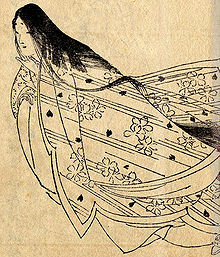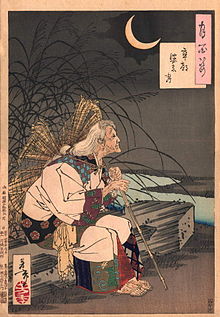- Ono no Komachi
-
In this Japanese name, the family name is "Ono".
 Ono no Komachi drawn by Kikuchi Yōsai
Ono no Komachi drawn by Kikuchi Yōsai
 Ono no Komachi as an old woman, a woodcut by Tsukioka Yoshitoshi
Ono no Komachi as an old woman, a woodcut by Tsukioka Yoshitoshi
Ono no Komachi (小野 小町, c. 825 – c. 900) was a famous Japanese waka poet, one of the Rokkasen—the Six best Waka poets of the early Heian period. She was noted as a rare beauty; Komachi is a symbol of a beautiful woman in Japan. She also figures among the Thirty-six Poetry Immortals.
Contents
Life and legends
The place of Komachi's birth and death is uncertain. According to one tradition, she was born in what is now Akita Prefecture, daughter of Yoshisada, "Lord of Dewa".[1] Her social status is also uncertain. She may have been a low-ranking consort or a lady-in-waiting of an emperor, possibly Emperor Ninmyō (r. 833-850).
As a poet, Komachi specialized in erotic love themes, expressed in complex poems.[2] Most of her waka are about anxiety, solitude or passionate love. She is the only female poet referred to in the preface of the Kokin Wakashū, which describes her style as "containing naivety in old style but also delicacy".
There are legends about Komachi in love. The most famous is a story about her relationship with Fukakusa no Shosho, a high-ranking courtier. Komachi promised that if he visited her continuously for a hundred nights, then she would become his lover. Fukakusa no Shosho visited her every night, but failed once towards the end. Despairing, he fell ill and subsequently died. When Komachi learned of his death she was overcome with sadness.
Legacy
Komachi sometimes features in later period literature, including five[3] Noh plays: Sotoba Komachi, Sekidera Komachi, Oomu Komachi, Sōshi Arai Komachi and Kayoi Komachi. These works tend to focus on her talent for waka and her love affairs and the vanity of a life spent indulging in romantic liaisons. Komachi's old age is also frequently portrayed: when she has lost her beauty, has been abandoned by her former lovers, and now regrets her life, wandering around as a lonely beggar woman — albeit still appreciated by young admirers of her poetry.[1] This is a fictional description influenced by Buddhist thought and there may be no factual resemblance between this portrait and the historical reality.
In honor of her, the Akita Shinkansen is nicknamed Komachi. Also a variety of rice, Akita Komachi bears her name. One of her 31-syllable poems was chosen by Fujiwara no Teika as an entry in the very popular anthology Hyakunin Isshu.
Sotoba Komachi ("Komachi on the stupa") is one of the Noh plays reworked from originals by Mishima Yukio for the modern theater. The basic plot (the age-worn former beauty encounters a young poet and relates some of her life story, which causes him to fall in love with her, with fatal results) is retained, but the action has been transferred to a public park, with flashbacks to the salons and ballrooms of the Meiji-era Japan. English translation by Donald Keene was published in 1967.
Ono no Komachi is also the subject of a modern one-woman play, Call Me Komachi, produced by Lemon Tart Productions, written by Christie Nieman, directed by Miki Oikawa and starring Kaori Hamamoto. Call Me Komachi enjoyed successful seasons at various venues in Australia from 2003 to 2006. The play compares and parallels the lives of traditional Geisha with contemporary Japanese schoolgirls in "paid dating", known as enjo kōsai.
Plays
Sotoba Komachi recounts the tale of a 9th century historical figure, once a legendary beauty, now cursed to live on in decreptitude possessed by the vengeful spirit of a taunted suitor. An encounter between two pilgrim monks and a mysterious old woman unfolds the drama. The Noh classic by Kan'ami (1336-1383) is performed with new music and choreography, initiating an aesthetic and thematic journey into the post-modern world of Samuel Beckett. (AKEMI HORIE[4])
Notes
- ^ a b Rexroth (1977:141)
- ^ "Her beauty may be legendary but her rank as one of the greatest erotic poets in any language is not. Her poems begin the extreme verbal complexity which distinguishes the poetry of the Kokinshū Anthology from the presentational immediacy of the Man'yōshū." Rexroth (1977:141)
- ^ Keene (1970:67)
- ^ http://www.ahorie.net/ - Director Akemi Horie and set design by Simon O'Corra
References
- Hirshfield, Jane; Mariko Aratani (1990). The Ink Dark Moon: Love Poems by Ono no Komachi and Izumi Shikibu, Women of the Ancient Court of Japan. New York: Vintage Books. ISBN 0-6797-2958-5.
- Keene, Donald (1970). Twenty Plays of the Nō Theater. New York: Columbia University Press. ISBN 0-2310-3454-7.
- Rexroth, Kenneth; Ikuko Atsumi (1977). Woman poets of Japan. New York: New Directions Pub. Corp.. ISBN 0-8112-0820-6.
Ariwara no Narihira · Sōjō Henjō · Kisen Hōshi · Ōtomo no Kuronushi · Fun'ya no Yasuhide ·
Ono no KomachiCategories:- 825 births
- 900 deaths
- Japanese poets
- Japanese writer stubs
- Asian poet stubs
Wikimedia Foundation. 2010.

